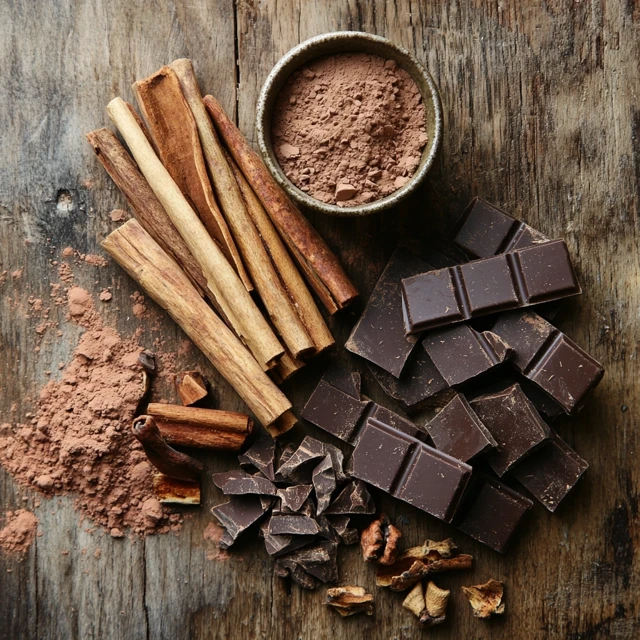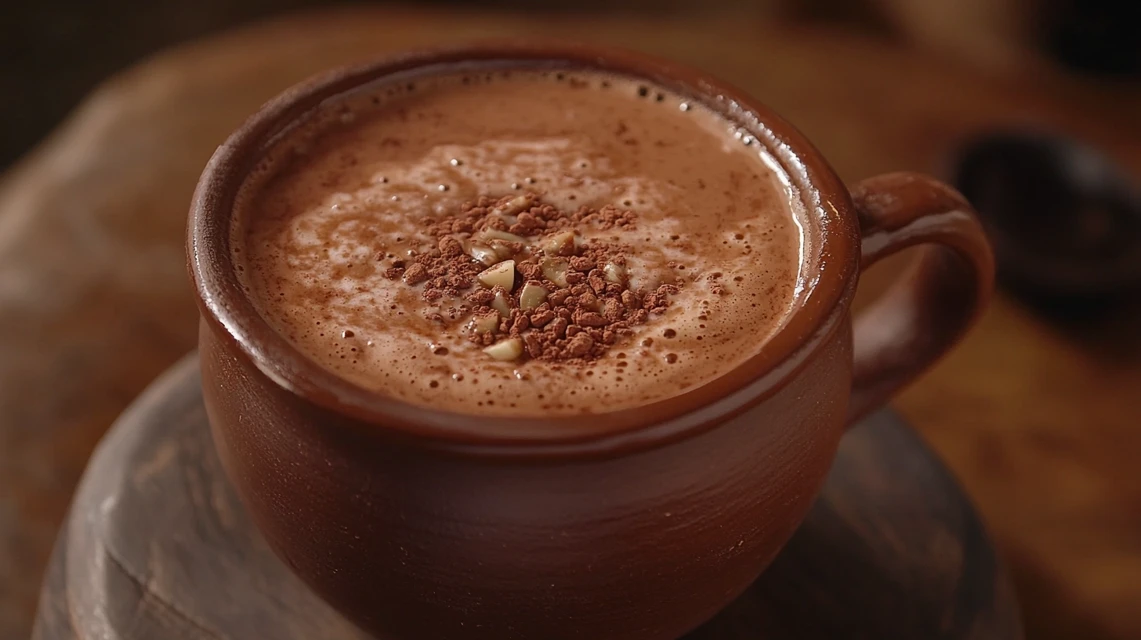Why Is Mexican Hot Chocolate Gritty?
First of all, people love Mexican hot chocolate because of its strong flavors, rich spices, and special feel in your mouth. Moreover, one thing that makes it different is that it feels a bit rough when you drink it, which might surprise some people at first, but then, as a result, helps them see it’s the real thing. Furthermore, when you learn why Mexican hot chocolate feels this way, you also learn about what goes into it, how people make it, and why it means so much to Mexican culture.
Understanding the Texture of Mexican Hot Chocolate
First of all, Mexican hot chocolate feels the way it does because of what goes into it and how people make it. Furthermore, while other places make smooth, factory-made hot chocolate, on the other hand, Mexican hot chocolate keeps its rough, homemade feel that, as a result, links it back to where it came from.
check out this https://eassyrecipes.com/category/breakfast/
The Unique Ingredients Used in Mexican Hot Chocolate
First of all, what goes into Mexican hot chocolate mainly creates its rough texture. Moreover, makers actually want these ingredients to stay a bit rough because, as a result, the drink feels more real and homemade.
- Mexican Chocolate Tablets:
- Mexican hot chocolate is typically made using chocolate tablets, which contain ground cacao, unrefined sugar, and cinnamon.
- The unrefined sugar often remains granulated, giving the drink a grainy consistency.
- Cocoa Nibs:
- Some chocolate tablets include ground cocoa nibs, which add a slightly coarse texture and a deeper chocolate flavor.
- Spices:
- Ingredients like cinnamon sticks and sometimes chili powder are blended into the drink, contributing to the overall texture.
Furthermore, by using natural ingredients that aren’t too processed, Mexican hot chocolate stays different from the very smooth store-bought kinds.
check out this https://eassyrecipes.com/category/breakfast/
How Traditional Preparation Methods Influence Texture

The traditional preparation of Mexican hot chocolate enhances its unique texture and flavor.
- The Molinillo Whisk:
- A carved wooden whisk called a molinillo is used to mix the hot chocolate. Rolling the molinillo between the palms creates a frothy layer on top but does not fully dissolve all the ingredients.
- Stovetop Preparation:
- Heating the chocolate and liquid on the stovetop allows the unrefined sugar and cocoa nibs to soften but not entirely dissolve, preserving their texture.
- Use of Water or Milk:
- First of all, people usually make Mexican hot chocolate with water, which, as a result, lets you taste and feel the real ingredients better. Moreover, while adding milk makes it creamy, the drink still keeps its rough texture.
The result is a drink that feels as authentic as it tastes, embracing its slightly gritty nature.
The Role of Mexican Chocolate Tablets
Mexican chocolate tablets are the cornerstone of this beloved beverage. Their composition and preparation process contribute significantly to the drink’s texture.
- Minimal Processing:
- Unlike smooth chocolate bars, Mexican chocolate tablets are minimally processed, retaining the raw texture of the cacao and sugar.
- Granulated Sugar:
- The unrefined sugar used in these tablets remains coarse, which adds to the drink’s rustic charm when melted.
- Flavor Infusion:
- Furthermore, the rough-ground ingredients let you taste the cacao and spices better, and as a result, give you flavors that smooth chocolate drinks can’t match.
These tablets are intentionally crafted to deliver the traditional texture and taste that define Mexican hot chocolate.
Cultural Significance of the Gritty Texture
The slightly grainy texture of Mexican hot chocolate is more than just a culinary choice—it carries cultural significance that connects it to its ancient roots and traditional practices.
check out this https://eassyrecipes.com/category/breakfast/
A Connection to Mesoamerican Roots
First of all, the rough texture of Mexican hot chocolate reminds us that old Mexican groups like the Aztecs and Mayans started making it this way.
- Traditional Xocoatl:
- The ancient version of hot chocolate, known as xocoatl, was made by grinding cacao beans with spices and water.
- This drink was unrefined and intentionally gritty, reflecting the natural ingredients used by these civilizations.
- Preserving Authenticity:
- By maintaining this texture, modern Mexican hot chocolate honors the methods and traditions of its Mesoamerican predecessors.
This connection to history makes each sip of Mexican hot chocolate a journey through time.
How the Texture Enhances the Drinking Experience
While the graininess of Mexican hot chocolate may seem unusual at first, it adds to the sensory experience of the drink.
- Rich Mouthfeel:
- The slightly coarse texture creates a satisfying contrast with the frothy top layer, making the drink more engaging.
- Flavor Intensity:
- The undissolved cocoa nibs and sugar crystals allow the flavors to linger on the palate, enhancing the overall taste.
- A Rustic Charm:
- The graininess gives the drink a homemade feel, making it more personal and comforting.
This texture isn’t a flaw—it’s a feature that sets Mexican hot chocolate apart and makes it memorable.
Why Authenticity Matters in Mexican Hot Chocolate
The gritty texture of Mexican hot chocolate is a hallmark of authenticity, reflecting its cultural and culinary heritage.
- Preserving Tradition:
- Maintaining the texture ensures that modern recipes stay true to the original methods and ingredients.
- Cultural Identity:
- The drink’s unique texture is a point of pride, showcasing the richness and diversity of Mexican cuisine.
- Connection to Community:
- Moreover, when people make and share Mexican hot chocolate the old way, it brings them together and, as a result, connects older and younger family members through the same experience.
Authenticity matters because it keeps the cultural story of Mexican hot chocolate alive.
How to Adapt Mexican Hot Chocolate to Personal Preferences

Mexican hot chocolate is loved for its unique texture and authentic taste, but preferences vary. For those who prefer a smoother version or want to experiment with modern approaches while honoring tradition, there are many ways to adapt this iconic drink to suit individual tastes.
Modern Tools for a Smoother Texture
One of the defining characteristics of Mexican hot chocolate is its slightly grainy texture, but modern tools can help achieve a smoother consistency without compromising flavor.
Blenders for a Velvety Drink
- High-Speed Blenders:
- Blending the prepared hot chocolate in a high-speed blender can break down the granulated sugar and cocoa nibs more effectively.
- This method ensures a silky texture while preserving the rich flavors of traditional Mexican chocolate.
- Immersion Blenders:
- An immersion blender allows you to blend directly in the pot, creating a smoother drink with less cleanup.
Fine Mesh Strainers
- Filtering the Mixture:
- Passing the prepared hot chocolate through a fine mesh strainer removes undissolved particles, resulting in a smooth finish.
- Balancing Flavor and Texture:
- Straining retains the authentic flavor of the ingredients while eliminating the graininess for those who prefer a polished drink.
Milk Frothers for Convenience
- Automatic Frothers:
- Modern milk frothers can both heat and froth the hot chocolate, creating a creamy top layer without manual whisking.
- Consistency Control:
- These devices offer a consistent froth, mimicking the traditional molinillo method with ease.
Modern tools make it possible to enjoy the essence of Mexican hot chocolate while catering to those who prefer a smoother texture.
Choosing the Right Type of Chocolate
First of all, the chocolate you pick makes a big difference in how your Mexican hot chocolate feels and tastes. Furthermore, when you choose the right kind, you can make the drink just the way you like it.
Traditional Mexican Chocolate Tablets
- Features:
- First of all, most people use Mexican chocolate tablets like Abuelita or Ibarra because they’re the old-school choice. Moreover, these tablets give you both the real rough texture and strong flavors that make the drink special.
- Best For:
- Those who value authenticity and enjoy the slightly gritty texture of traditional Mexican hot chocolate.
Artisanal Mexican Chocolate
- Features:
- Handmade artisanal chocolates often have a coarser texture and deeper flavors. Some are infused with unique spices or ingredients like almonds.
- Best For:
- Enthusiasts looking to explore regional variations and premium options.
Smooth European-Style Chocolate
- Features:
- European-style chocolates, such as dark chocolate bars or cocoa powder, can be used for a smoother version of Mexican hot chocolate.
- Best For:
- Those who prefer a silky drink without the rustic texture of traditional tablets.
By experimenting with different types of chocolate, you can create a version of Mexican hot chocolate that aligns with your taste preferences.
Balancing Tradition and Modernity
Adapting Mexican hot chocolate to suit modern preferences doesn’t mean abandoning tradition. With a thoughtful approach, you can enjoy a personalized version while honoring the drink’s cultural roots.
Preserving Key Elements
- Spices and Flavors:
- Retain the essential spices like cinnamon and chili powder to ensure the drink maintains its distinct Mexican identity.
- Authentic Tools:
- Even when using modern equipment, incorporating a traditional molinillo for frothing adds a cultural touch.
Incorporating Modern Ingredients
- Alternative Sweeteners:
- Use honey, agave syrup, or coconut sugar for a natural sweetness that aligns with contemporary dietary preferences.
- Non-Dairy Milks:
- Almond, oat, or coconut milk can replace traditional milk or water, offering a creamy and dairy-free option.
Experimenting with Textures
- Hybrid Techniques:
- Combine traditional and modern methods, such as starting with a molinillo for frothing and finishing with a blender for smoothness.
- Custom Consistency:
- Adjust the thickness by controlling the amount of liquid or adding more chocolate tablets for a richer texture.
Balancing tradition and modernity allows you to enjoy the best of both worlds—a drink that pays homage to its roots while meeting your unique preferences.
FAQs About Mexican Hot Chocolate Texture
First of all, when people try Mexican hot chocolate for the first time, they often ask about why it feels rough in their mouth. Therefore, to help you understand why people love this special texture and how it makes the drink better, here are answers to common questions.
Why Is Mexican Hot Chocolate Grainy?
The grainy texture of Mexican hot chocolate is a hallmark of its authenticity, resulting from the ingredients and preparation methods rooted in tradition.
Key Reasons for the Graininess:
- Unrefined Sugar:
- Mexican chocolate tablets are made with piloncillo (unrefined cane sugar), which remains granulated even after heating, contributing to the texture.
- Ground Cocoa Nibs:
- Unlike processed cocoa powder, Mexican chocolate contains ground cocoa nibs that provide a slightly coarse texture.
- Minimal Processing:
- The chocolate used is less refined, preserving its natural, rustic feel.
This graininess is not a flaw but a deliberate feature that connects the drink to its Mesoamerican roots.
Why Is Mexican Hot Chocolate Gritty?
Why Is My Hot Chocolate Gritty?
If your hot chocolate turns out gritty, it may be due to the type of chocolate or preparation method used. While graininess is expected in traditional Mexican hot chocolate, it can also result from other factors.
Common Causes:
- Undissolved Chocolate:
- If the chocolate is not fully melted during preparation, small chunks may remain, leading to a gritty texture.
- Temperature Control:
- Heating the liquid too quickly can prevent the chocolate from dissolving evenly.
- Use of Authentic Ingredients:
- If you’re using Mexican chocolate tablets, the gritty texture is intentional and adds to the authenticity of the drink.
How to Avoid Unwanted Grittiness:
- Stir the chocolate consistently while heating to ensure it dissolves completely.
- Use a molinillo or immersion blender for thorough mixing.
- Strain the drink through a fine mesh if you prefer a smoother texture.
Understanding the source of the grittiness can help you decide whether to embrace it as part of the experience or adjust your preparation methods.
Why Is Mexican Hot Chocolate Gritty?
Is Abuelita Chocolate Supposed to Be Grainy?
Yes, Abuelita chocolate is designed to be grainy. This texture is a signature characteristic of Mexican hot chocolate and a defining feature of the Abuelita brand.
Why It’s Grainy:
- Ingredients:
- Abuelita chocolate tablets contain unrefined sugar and ground cocoa, which naturally result in a coarse texture.
- Traditional Design:
- The graininess reflects traditional preparation methods and adds an authentic feel to the drink.
- Enhanced Flavor:
- The unrefined sugar and cocoa nibs provide a richer, more complex flavor profile than smooth, processed chocolates.
For those accustomed to smoother hot chocolate, Abuelita’s graininess might be surprising at first, but it’s a key element of its appeal.
Why Is Mexican Hot Chocolate Different?
Why Is Mexican Hot Chocolate Gritty?
Mexican hot chocolate is different from other types of hot chocolate due to its unique ingredients, preparation, and cultural significance.
Distinctive Features:
- Spices:
- First of all, people often add cinnamon to Mexican hot chocolate, and furthermore, sometimes they put in chili powder, which, as a result, creates warm, spicy flavors.
- Texture:
- Moreover, its rough texture makes it different from the smooth hot chocolate you find in other places.
- Frothing Method:
- A molinillo whisk is used to create a frothy top layer, adding to the sensory experience.
- Cultural Roots:
- It is deeply tied to Mexican traditions, often enjoyed during celebrations and paired with foods like pan dulce.
Therefore, all these things come together to make Mexican hot chocolate a special drink that, as a result, people remember and love for both its taste and how it feels.
Conclusion
First of all, Mexican hot chocolate has a rough texture that shows it’s true to its roots and, as a result, carries deep meaning in Mexican culture. Moreover, this comes from many things: the rough sugar in Abuelita chocolate, the crushed cocoa bits in old-style chocolate blocks, and the ways families have taught their children to make it over many years. However, if you like your drink smoother, you can still use new tools to make it differently while keeping all its rich flavors. Therefore, the grainy feel of Mexican hot chocolate isn’t just about how it feels on your tongue—furthermore, it links back to its old Mexican roots and, as a result, shows why the old ways of making it are so special.

